window SKODA SUPERB 2003 1.G / (B5/3U) Owner's Guide
[x] Cancel search | Manufacturer: SKODA, Model Year: 2003, Model line: SUPERB, Model: SKODA SUPERB 2003 1.G / (B5/3U)Pages: 259
Page 114 of 259

Heating and air conditioning system 113
Using the systemSafetyDriving TipsGeneral MaintenanceBreakdown assistanceTechnical Data
WARNING
•If the Climatronic system is swit ched off (OFF), there is no
supply of fresh air from the outside. “Stale air” may result in fatigue
in the driver and passengers, reduce attention levels and also
cause the windows to mist up. The risk of having an accident
increases.
•Do not switch the Climatronic system off for longer than neces-
sary.
Page 116 of 259
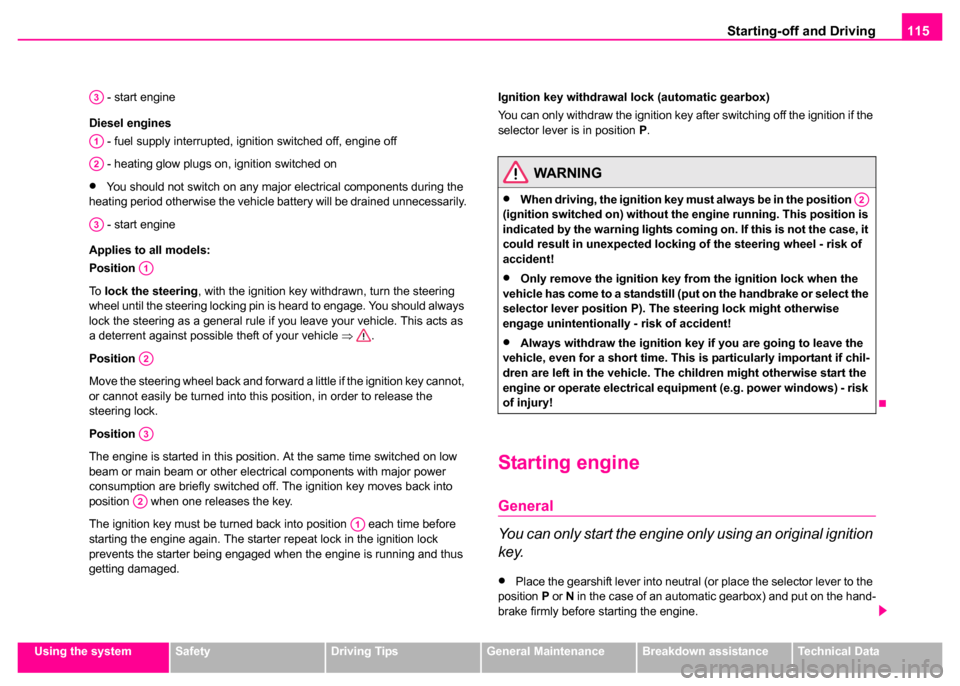
Starting-off and Driving115
Using the systemSafetyDriving TipsGeneral MaintenanceBreakdown assistanceTechnical Data
- start engine
Diesel engines - fuel supply interrupted, ignition switched off, engine off
- heating glow plugs on, ignition switched on
•You should not switch on any major electrical components during the
heating period otherwise the vehicle battery will be drained unnecessarily.
- start engine
Applies to all models:
Position
To lock the steering , with the ignition key withdrawn, turn the steering
wheel until the steering locking pin is heard to engage. You should always
lock the steering as a general rule if you leave your vehicle. This acts as
a deterrent against possible theft of your vehicle ⇒.
Position
Move the steering wheel back and forward a little if the ignition key cannot,
or cannot easily be turned into this position, in order to release the
steering lock.
Position
The engine is started in this position. At the same time switched on low
beam or main beam or other electrical components with major power
consumption are briefly switched off. The ignition key moves back into
position when one releases the key.
The ignition key must be turned back into position each time before
starting the engine again. The starter repeat lock in the ignition lock
prevents the starter being engaged when the engine is running and thus
getting damaged. Ignition key withdrawal lock (automatic gearbox)
You can only withdraw the ignition key after switching off the ignition if the
selector lever is in position
P.
Starting engine
General
You can only start the engine only using an original ignition
key.
•Place the gearshift lever into neutral (or place the selector lever to the
position P or N in the case of an automatic gearbox) and put on the hand-
brake firmly before starting the engine.
A3
A1
A2
A3
A1
A2
A3
A2
A1
WARNING
•When driving, the ignition key must always be in the position
(ignition switched on) without the engine running. This position is
indicated by the warning lights coming on. If this is not the case, it
could result in unexpected locking of the steering wheel - risk of
accident!
•Only remove the ignition key fr om the ignition lock when the
vehicle has come to a standstill (put on the handbrake or select the
selector lever position P). The steering lock might otherwise
engage unintentionally - risk of accident!
•Always withdraw the ignition key if you are going to leave the
vehicle, even for a short time. This is particularly important if chil-
dren are left in the vehicle. The children might otherwise start the
engine or operate electrical equipment (e.g. power windows) - risk
of injury!
A2
Page 154 of 259

Airbag system153
Using the systemSafetyDriving TipsGeneral MaintenanceBreakdown assistanceTechnical Data
If the head airbag is deployed, the airbag is filled with propellant gas and
extends over the entire area of the side window including the door pillars
⇒
page 152, fig. 134 . The protection offered by the head airbags is thus
available simultaneously both to the front occupants of the car seated on
the side on which the accident occurs, as well as to the rear occupants.
Any impact of the head against parts of the interior or objects outside of
the car, is cushioned by the inflated head airbag. The reduction in any
impact to the head and the resultant minimizing of any movements of the
head additionally reduce the risk of injuries to the neck area. The head
airbag also offers additional protection in the case of an offset impact by
covering the front door pillar.
In certain accident situations both the front airbags as well as the side and
head airbags may be deployed together.
The airbags inflate in fractions of a second and at a high speed in order to
be able to offer that additional protection in the event of an accident. A fine
dust is produced when airbag inflated. This is perfectly normal and is not
an indication of a fire in the vehicle.
Important safety informat ion on the head airbag
Correct use of the airbag system considerably reduces the
risk of injury!
WARNING
•It is essential to always switch off ⇒page 154 the front
passenger airbag when attaching a child safety seat on the front
passenger seat where the child is seated with its back facing in
direction of travel (in some countries also when the child is facing
the direction of travel). If this is not done, there is a risk of the child
suffering severe or even fatal injuries if the front passenger airbag
is deployed. In certain countries national legal provisions also
require that the side or head passenger airbags be deactivated.
When transporting a child on the front passenger seat, please
comply with the appropriate national regulations regarding the use
of child safety seats.
•There must not be any objects in the deployment area of the
head airbags which might prevent the airbags from inflating prop-
erly.
•Only hang light items of clothing on the clothes hooks to the
vehicle. Never leave any heavy or sharp-edged objects in the
pockets of the items of clothing. In addition, it is not permitted to
use clothes hangers for hanging up items of clothing.
•There must not be any other persons (e.g. children) or animals
between the car occupant and the deployment area of the head
airbag. In addition, none of the occupants should lean their head
out of the window when driving, or extend their arms and hands
out of the window.
Page 155 of 259

Airbag system
154
Deactivating an airbag
Deactivating airbags
If any airbags have been deactivated, switch them on
again as soon as possible so that they are able to again
provide their proper protection.
There is the technical means installed within your vehicle to switch off the
front, side or head airbag (take out of commission).
This is why you should have the deactivation of the airbags carried out by
a Škoda dealer. On vehicles equipped with the switch for deactivation of the airbags, you
can deactivate the front and side passenger airbag by means of this
switch
⇒page 155.
Deactivation of airbags is envisaged only for particular instances,
such as if
•Yo u m u s t i n exceptional cases use a child seat on the front
passenger seat where the child is seated with its back to the direction of
travel (in some countries this must be in the direction of travel due to other
legal regulations applying) ⇒page 157.
•You are not able to maintain the distance of at least 25 cm between
middle of steering wheel and chest, despite the driver seat being correctly
adjusted.
•Special attachments are required in the area of the steering wheel
because of a physical disability.
•You have installed other seats (e.g. orthopaedic seats without side
airbags).
Monitoring the airbag system
The functionality of the airbag system is monitored electronically, also
when the airbags have been switched off
An airbag which has been switched off by a Skoda dealer using the
vehicle system tester:
•The warning light for the airbag system lights up for 3 seconds after
switching on the ignition and then flashes for 12 seconds afterwards in 2
second intervals.
Front passenger airbags switched off using the switch for front
passenger airbags* in stowage compartment on the front passenger
side:
•The airbag indicator light in the instrument cluster comes on for about
3 seconds each time the ignition is switched on.
WARNING (continued)
•The sun visors must not be swivelled to the side windows into
the deployment area of the head airbags if any objects, such as
ball-point pens etc. are attached to them. This might result in inju-
ries to the occupants if the head airbag is deployed.
•Installing accessories in the area of the head airbag may
considerably impair the protection offered by the head airbag in
the event of it being deployed. When the deployed head airbag is
inflated, parts of the accessories fitted may in certain circum-
stances be thrown into the interior of the car and cause injuries to
the occupants.
•Any work on the head airbag system including installing and
removing system components because of other repair work (e.g.
removing headliner) must only be carried out by a Škoda Dealer.
Page 191 of 259

Care and cleaning
190
Automatic vehicle wash systems
The paintwork of the vehicle is sufficiently resistant that the vehicle can be
washed normally in automatic vehicle wash plants without any problem.
The actual stress to which the paintwork is subjected, however, depends
greatly on the design of the vehicle wash system, the filtering of the water
and the type of washing and care products used. If the paintwork of your
vehicle appears mat after being washed or even has scratches, point this
out to the operator of the vehicle wash plant. Use a different vehicle wash
plant, if necessary.
There are no particular points to note before washing your vehicle in such
a plant other than the usual precautionary measures (closing windows
and sliding/tilting roof, moving any factory-fitted aerials down flat against
the bodywork, etc.).
If you have any particular attached parts fitted to your car - such as spoiler,
roof rack system, two-way radio aerial - it is best to first of all consult the
operator of the car wash plant.
It is important to degrease the lips of the windscreen wiper rubbers after
passing through the automatic vehicle wash system.
Caution
Do not screw the swivelling down roof aerial tight before washing the
vehicle in an automatic vehicle wash system - risk of damage!
Washing vehicle by hand
It is important to first soften the dirt with plenty of water and rinse it off as
thoroughly as possible before washing your vehicle by hand.
One should then clean the vehicle using a soft washing sponge,
washing glove or a washing brush and only slight pressure. Work from
the top to the bottom - beginning with the roof. Only place slight pressure
on the vehicle paintwork during cleaning Only use a shampoo for stub-
born dirt.
Wash out the sponge or washing glove thoroughly at short intervals.
Clean wheels, door sills and similar parts last. Use a second sponge for
such areas.
Rinse off the vehicle well after giving it a wash and dry it off using a
chamois leather.
Caution
•Do not wash your vehicle in bright sunlight - risk of paint damage.
•Ensure that the jet of water is not aimed directly at the locks or at the
door and panel joints if you spray your vehicle in winter down with a hose
- risk of freezing.
•Do not use any insect sponges, rough kitchen sponges or similar
cleaning products - risk of damage to the surface of paintwork.
WARNING
When washing your vehicle in the winter: Water and ice in the
brake system can affect the braking efficiency - risk of accident.
WARNING
•The ignition should always be switched off when you wash your
vehicle - risk of accident!
•Protect your hands and arms from sharp-edged metal parts
when you are cleaning the underfloor, the inside of the wheel hous-
ings or the wheel trims - risk of cuts.
Page 192 of 259

Care and cleaning191
Using the systemSafetyDriving TipsGeneral MaintenanceBreakdown assistanceTechnical Data
For the sake of the environment
Only wash your vehicle at washing bays specifically reserved for this
purpose. This ensures that no water which may be contaminated by oil
flows into the sewage system. It is not even permitted to wash your vehicle
in certain areas except at such specific washing bays.
Washing with a high-pressure cleaner
When you wash your vehicle with a high-pressure cleaner, it is essential
to comply with the instructions for use of the cleaning equipment. This
applies in particular to the pressure used and to the spraying distance .
Maintain a sufficiently large distance to soft materials such as rubber
hoses or insulation material.
On no account use circular spray nozzles or so-called dirt cutters .
The water containing wax must be no hotter than 60°C.
Caution
It is particularly important that you do not clean tyres with circular spray
jets. Damage to tyres may occur even at a relatively large spraying
distance and if sprayed only for a short time.
Wax treatment
Good wax treatment is an effective way of protecting the paintwork from
harmful environmental influences and minor mechanical damage.
A new layer of a high-quality hard wax polish can be applied to the clean
bodywork after it has dried thoroughly. Even if you use a wax preserver regularly we still recommend that you treat the paintwork of the vehicle at
least twice a year with hard wax.
Caution
Never apply wax to the windows.
Polishing
Polishing is only necessary if the paintwork of your vehicle has become
unattractive and if it is no longer possible to achieve a gloss with wax
preservers.
You must treat the paintwork with a wax preserver if the polish you use
does not contain any preserving elements
⇒page 191, “Wax treatment”.
We recommend using a preservative from the range of accessories
offered by your Skoda dealer.
Caution
You must not treat mat painted parts or plastic with polishing products or
hard wax.
Trim strips
Use pH neutral care products to remove stains and coatings on trim
strips - in other words not chrome care products. Škoda Dealers have
available a range of environmentally compatible cleaning products which
have been tested and approved for your car.
Page 193 of 259
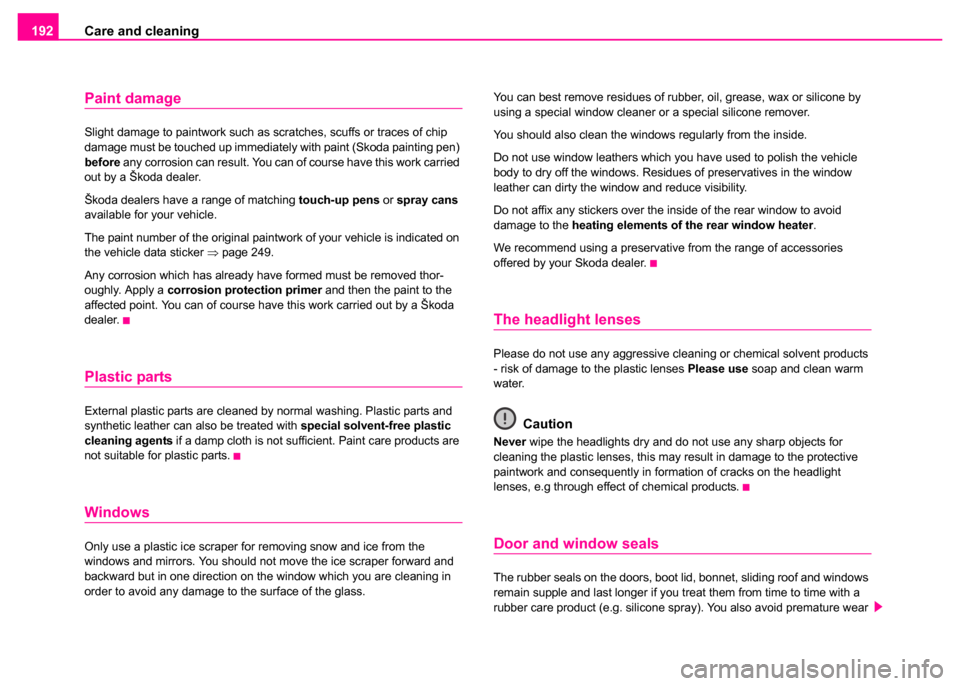
Care and cleaning
192
Paint damage
Slight damage to paintwork such as scratches, scuffs or traces of chip
damage must be touched up immediately with paint (Skoda painting pen)
before any corrosion can result. You can of course have this work carried
out by a Škoda dealer.
Škoda dealers have a range of matching touch-up pens or spray cans
available for your vehicle.
The paint number of the original paintwork of your vehicle is indicated on
the vehicle data sticker ⇒page 249.
Any corrosion which has already have formed must be removed thor-
oughly. Apply a corrosion protection primer and then the paint to the
affected point. You can of course have this work carried out by a Škoda
dealer.
Plastic parts
External plastic parts are cleaned by normal washing. Plastic parts and
synthetic leather can also be treated with special solvent-free plastic
cleaning agents if a damp cloth is not sufficient. Paint care products are
not suitable for plastic parts.
Windows
Only use a plastic ice scraper for removing snow and ice from the
windows and mirrors. You should not move the ice scraper forward and
backward but in one direction on the window which you are cleaning in
order to avoid any damage to the surface of the glass. You can best remove residues of rubber, oil, grease, wax or silicone by
using a special window cleaner or a special silicone remover.
You should also clean the windows regularly from the inside.
Do not use window leathers which you have used to polish the vehicle
body to dry off the windows. Residues of preservatives in the window
leather can dirty the window and reduce visibility.
Do not affix any stickers over the inside of the rear window to avoid
damage to the
heating elements of the rear window heater .
We recommend using a preservative from the range of accessories
offered by your Skoda dealer.
The headlight lenses
Please do not use any aggressive cleaning or chemical solvent products
- risk of damage to the plastic lenses Please use soap and clean warm
water.
Caution
Never wipe the headlights dry and do not use any sharp objects for
cleaning the plastic lenses, this may result in damage to the protective
paintwork and consequently in formation of cracks on the headlight
lenses, e.g through effect of chemical products.
Door and window seals
The rubber seals on the doors, boot lid, bonnet, sliding roof and windows
remain supple and last longer if you treat them from time to time with a
rubber care product (e.g. silicone spray). You also avoid premature wear
Page 217 of 259
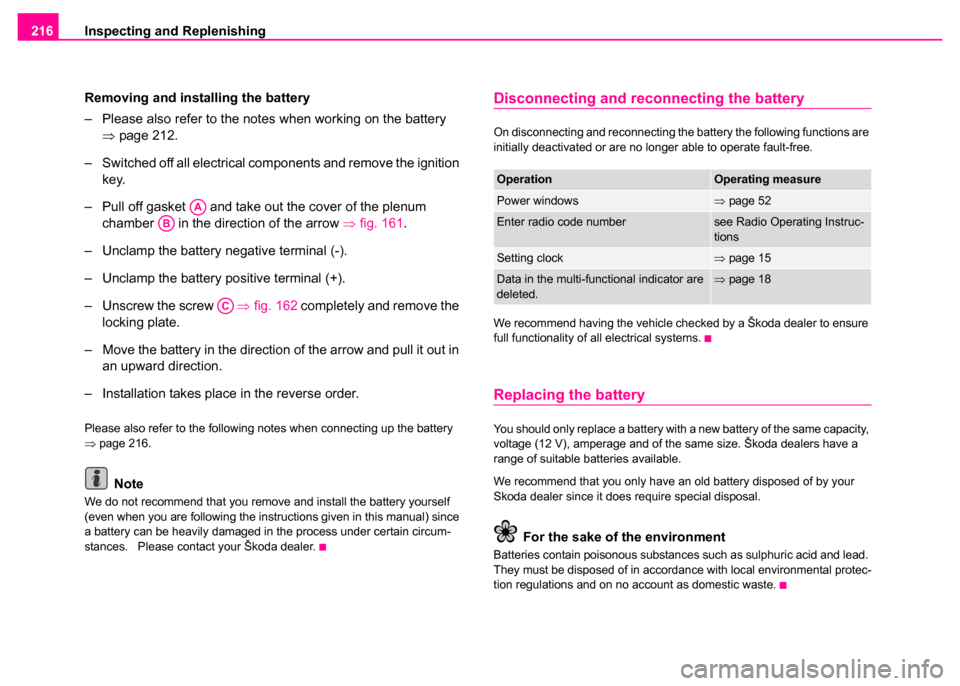
Inspecting and Replenishing
216
Removing and installing the battery
– Please also refer to the notes when working on the battery ⇒page 212.
– Switched off all electrical components and remove the ignition key.
– Pull off gasket and take out the cover of the plenum chamber in the direction of the arrow ⇒fig. 161 .
– Unclamp the battery negative terminal (-).
– Unclamp the battery positive terminal (+).
– Unscrew the screw ⇒fig. 162 completely and remove the
locking plate.
– Move the battery in the direction of the arrow and pull it out in an upward direction.
– Installation takes place in the reverse order.
Please also refer to the following notes when connecting up the battery
⇒ page 216.
Note
We do not recommend that you remove and install the battery yourself
(even when you are following the instructions given in this manual) since
a battery can be heavily damaged in the process under certain circum-
stances. Please contact your Škoda dealer.
Disconnecting and reconnecting the battery
On disconnecting and reconnecting the battery the following functions are
initially deactivated or are no longer able to operate fault-free.
We recommend having the vehicle checked by a Škoda dealer to ensure
full functionality of all electrical systems.
Replacing the battery
You should only replace a battery with a new battery of the same capacity,
voltage (12 V), amperage and of the same size. Škoda dealers have a
range of suitable batteries available.
We recommend that you only have an old battery disposed of by your
Skoda dealer since it does require special disposal.
For the sake of the environment
Batteries contain poisonous substances such as sulphuric acid and lead.
They must be disposed of in accordance with local environmental protec-
tion regulations and on no account as domestic waste.
AA
AB
AC
OperationOperating measure
Power windows⇒page 52
Enter radio code numbersee Radio Operating Instruc-
tions
Setting clock⇒page 15
Data in the multi-functional indicator are
deleted.⇒page 18
Page 244 of 259
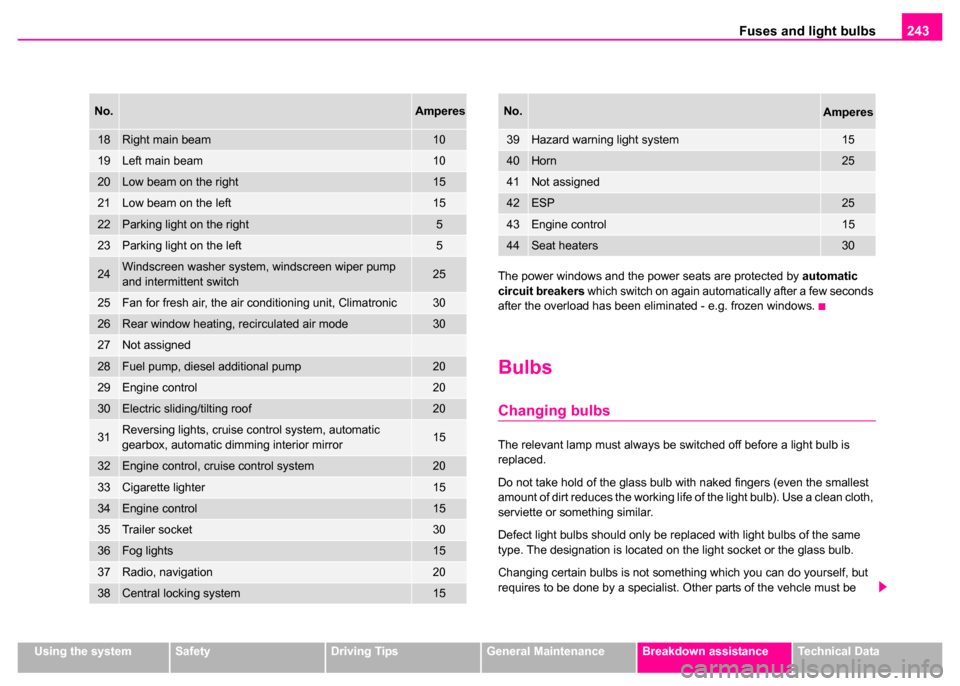
Fuses and light bulbs243
Using the systemSafetyDriving TipsGeneral MaintenanceBreakdown assistanceTechnical Data
The power windows and the power seats are protected by
automatic
circuit breakers which switch on again automatically after a few seconds
after the overload has been eliminated - e.g. frozen windows.
Bulbs
Changing bulbs
The relevant lamp must always be switched off before a light bulb is
replaced.
Do not take hold of the glass bulb with naked fingers (even the smallest
amount of dirt reduces the working life of the light bulb). Use a clean cloth,
serviette or something similar.
Defect light bulbs should only be replaced with light bulbs of the same
type. The designation is located on the light socket or the glass bulb.
Changing certain bulbs is not something which you can do yourself, but
requires to be done by a specialist. Other parts of the vehcle must be
18Right main beam10
19Left main beam10
20Low beam on the right15
21Low beam on the left15
22Parking light on the right5
23Parking light on the left5
24Windscreen washer system, windscreen wiper pump
and intermittent switch25
25Fan for fresh air, the air conditioning unit, Climatronic30
26Rear window heating, recirculated air mode30
27Not assigned
28Fuel pump, diesel additional pump20
29Engine control20
30Electric sliding/tilting roof20
31Reversing lights, cruise control system, automatic
gearbox, automatic dimming interior mirror15
32Engine control, cruise control system20
33Cigarette lighter15
34Engine control15
35Trailer socket30
36Fog lights15
37Radio, navigation 20
38Central locking system15
No.Amperes
39Hazard warning light system15
40Horn25
41Not assigned
42ESP25
43Engine control15
44Seat heaters30
No.Amperes
Page 253 of 259
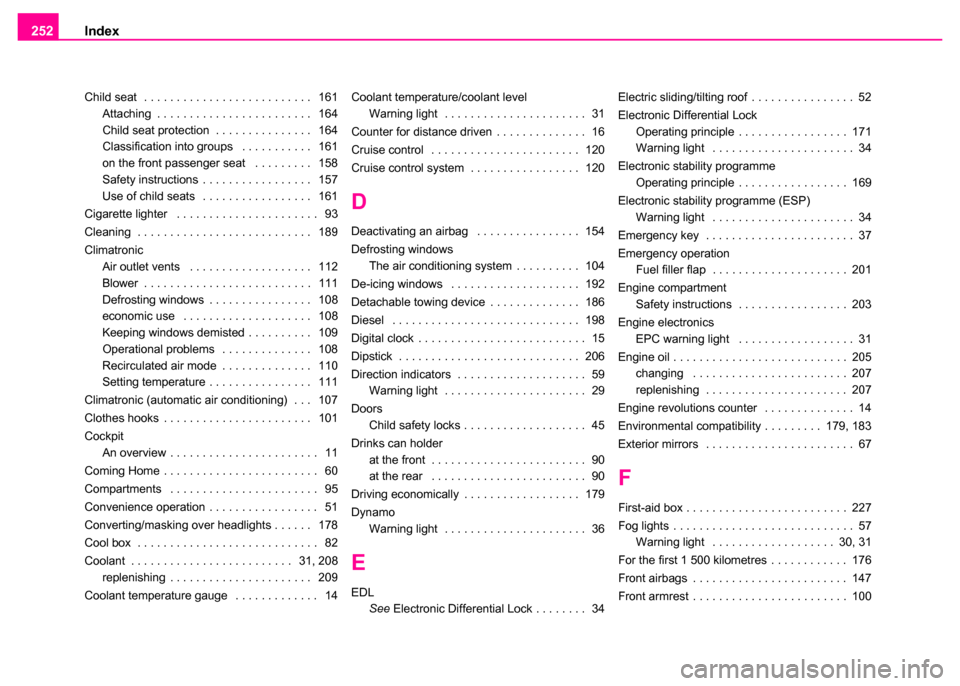
Index
252
Child seat . . . . . . . . . . . . . . . . . . . . . . . . . . 161
Attaching . . . . . . . . . . . . . . . . . . . . . . . . 164
Child seat protection . . . . . . . . . . . . . . . 164
Classification into groups . . . . . . . . . . . 161
on the front passenger seat . . . . . . . . . 158
Safety instructions . . . . . . . . . . . . . . . . . 157
Use of child seats . . . . . . . . . . . . . . . . . 161
Cigarette lighter . . . . . . . . . . . . . . . . . . . . . . 93
Cleaning . . . . . . . . . . . . . . . . . . . . . . . . . . . 189
Climatronic Air outlet vents . . . . . . . . . . . . . . . . . . . 112
Blower . . . . . . . . . . . . . . . . . . . . . . . . . . 111
Defrosting windows . . . . . . . . . . . . . . . . 108
economic use . . . . . . . . . . . . . . . . . . . . 108
Keeping windows demisted . . . . . . . . . . 109
Operational problems . . . . . . . . . . . . . . 108
Recirculated air mode . . . . . . . . . . . . . . 110
Setting temperature . . . . . . . . . . . . . . . . 111
Climatronic (automatic air conditioning) . . . 107
Clothes hooks . . . . . . . . . . . . . . . . . . . . . . . 101
Cockpit An overview . . . . . . . . . . . . . . . . . . . . . . . 11
Coming Home . . . . . . . . . . . . . . . . . . . . . . . . 60
Compartments . . . . . . . . . . . . . . . . . . . . . . . 95
Convenience operation . . . . . . . . . . . . . . . . . 51
Converting/masking over headlights . . . . . . 178
Cool box . . . . . . . . . . . . . . . . . . . . . . . . . . . . 82
Coolant . . . . . . . . . . . . . . . . . . . . . . . . . 31, 208 replenishing . . . . . . . . . . . . . . . . . . . . . . 209
Coolant temperature gauge . . . . . . . . . . . . . 14 Coolant temperature/coolant level
Warning light . . . . . . . . . . . . . . . . . . . . . . 31
Counter for distance driven . . . . . . . . . . . . . . 16
Cruise control . . . . . . . . . . . . . . . . . . . . . . . 120
Cruise control system . . . . . . . . . . . . . . . . . 120
D
Deactivating an airbag . . . . . . . . . . . . . . . . 154
Defrosting windows The air conditioning system . . . . . . . . . . 104
De-icing windows . . . . . . . . . . . . . . . . . . . . 192
Detachable towing device . . . . . . . . . . . . . . 186
Diesel . . . . . . . . . . . . . . . . . . . . . . . . . . . . . 198
Digital clock . . . . . . . . . . . . . . . . . . . . . . . . . . 15
Dipstick . . . . . . . . . . . . . . . . . . . . . . . . . . . . 206
Direction indicators . . . . . . . . . . . . . . . . . . . . 59 Warning light . . . . . . . . . . . . . . . . . . . . . . 29
Doors Child safety locks . . . . . . . . . . . . . . . . . . . 45
Drinks can holder at the front . . . . . . . . . . . . . . . . . . . . . . . . 90
at the rear . . . . . . . . . . . . . . . . . . . . . . . . 90
Driving economically . . . . . . . . . . . . . . . . . . 179
Dynamo Warning light . . . . . . . . . . . . . . . . . . . . . . 36
E
EDLSee Electronic Differential Lock . . . . . . . . 34 Electric sliding/tilting roof . . . . . . . . . . . . . . . . 52
Electronic Differential Lock
Operating principle . . . . . . . . . . . . . . . . . 171
Warning light . . . . . . . . . . . . . . . . . . . . . . 34
Electronic stability programme Operating principle . . . . . . . . . . . . . . . . . 169
Electronic stability programme (ESP) Warning light . . . . . . . . . . . . . . . . . . . . . . 34
Emergency key . . . . . . . . . . . . . . . . . . . . . . . 37
Emergency operation Fuel filler flap . . . . . . . . . . . . . . . . . . . . . 201
Engine compartment Safety instructions . . . . . . . . . . . . . . . . . 203
Engine electronics EPC warning light . . . . . . . . . . . . . . . . . . 31
Engine oil . . . . . . . . . . . . . . . . . . . . . . . . . . . 205 changing . . . . . . . . . . . . . . . . . . . . . . . . 207
replenishing . . . . . . . . . . . . . . . . . . . . . . 207
Engine revolutions counter . . . . . . . . . . . . . . 14
Environmental compatibility . . . . . . . . . 179, 183
Exterior mirrors . . . . . . . . . . . . . . . . . . . . . . . 67
F
First-aid box . . . . . . . . . . . . . . . . . . . . . . . . . 227
Fog lights . . . . . . . . . . . . . . . . . . . . . . . . . . . . 57 Warning light . . . . . . . . . . . . . . . . . . . 30, 31
For the first 1 500 kilometres . . . . . . . . . . . . 176
Front airbags . . . . . . . . . . . . . . . . . . . . . . . . 147
Front armrest . . . . . . . . . . . . . . . . . . . . . . . . 100